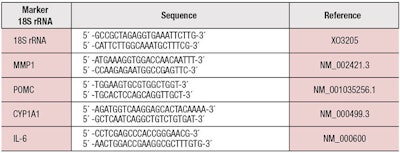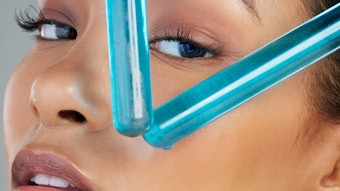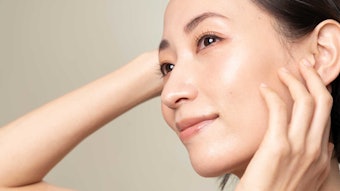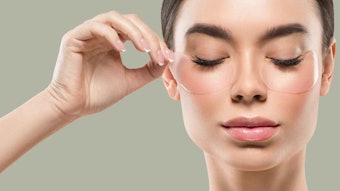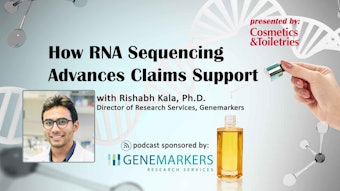
More than 80% of consumers worldwide think skin absorbs pollution from the air. Pollution, dirt and chemicals from vehicle emissions, plants, factories, cigarette smoke, etc., are seen by consumers as the second largest cause of skin, scalp and hair problems across the globe; the first is lack of sleep. In some countries, e.g., Russia and China, air pollution is considered a predominant cause of hair and skin problems—even more than sun exposure. Those most sensitive to dust and dirt are consumers in Brazil, Mexico, Pakistan and India, followed by Russia and China.4
This consumer perception is based in part on epidemiological studies showing that human exposure to airborne, traffic-related particulate matter (PM) is associated with increased signs of extrinsic skin aging, including wrinkle formation and, most importantly, pigment spot formation.1-3 This effect was strongest with soot, indicating it might be due to carbon particles having a size in the nano- to micrometer range and/or organic substances bound to the surface of these particles; particularly polyaromatic hydrocarbons (PAH) such as benzo[a]pyrene (BaP).
The sources of the air pollutants are diverse including, as noted, vehicular traffic and exhausts, coal burning power plants and industrial combustion, cigarette smoke, but also indoor domestic kitchen cooking fires. The World Health Organization (WHO) encourages governments in cities to monitor the pollution in air.5 Measurements are recorded for the parameters PM2.5 and PM10, i.e., the concentrations of airborne particulate matter with a diameter of less than 2.5 µm and less than 10 µm, respectively.
In fact, for large cities, consumers are able to check, based on forecasts given by the government and available on the internet and via apps, their exposure to PM for the day. As it is difficult to completely avoid exposure to PM, consumers are looking for alternate ways to protect the skin, with increasing demand for cosmetic products having such special protective effects.
Recent scientific work has shown the exposure of human epidermal keratinocytes to particulate matter causes activation of the aryl hydrocarbon receptor (AhR), which induces the expression of genes responsible for premature skin aging and dark spot formation.6 Here, the authors developed a method to measure the protective effects of a recently identified AhR antagonist, E/Z-2-benzylindene-5,6-dimethoxy-3,3-dimethylindan-1-one (BDDI)a,7 against premature aging induced by diesel exhaust particles (DEPs).
Materials and Methods
Cell culture: Adult human epidermal keratinocytes were kept sub-confluent in 12-well plates for culture and treatment with DEPs. Twenty-four hours prior to addition of DEPs, keratinocytes were starved in keratinocyte medium without bovine pituitary extract (BPE) or epidermal growth factor (EGF). The test compound BDDI (see Figure 1) was dissolved in dimethyl sulfoxide (DMSO, 10 mM) and applied 2 hr prior to treatment with the DEPs.
Model DEPs: Standard reference materials (SRMs) SRM1650b and SRM2975b were used as surrogates for authentic street particulate matter. SRM1650b was collected from the heat exchangers of a dilution tube facility to represent heavy-duty diesel engine particulate emissions. SRM2975 was collected from an industrial diesel-powered forklift. Both SRMs were previously described in detail8 and well-characterized (see Table 1).9, 10 The SRMs were suspended in phosphate buffered saline and sonicated for 1 min, then directly added to the keratinocytes at a concentration of 1.5 µg cm2.
RNA isolation and PCR: Total RNA was prepared as described elsewhere.11 Cyp1A1 gene as a marker for AhR activation and matrix metalloproteinase-1 (MMP-1) gene as a marker for wrinkle formation were quantified 6 hr after application of DEPs. Also, the interleukin-6 (IL-6) gene as a maker for inflammation and inflammaging, and the proopiomelanocortin (POMC) gene as a marker for hyperpigmentation and pigment spot formation were quantified 24 hr after application of DEPs by qRT-PCR (see Table 2). Three samples for each condition were processed with two determinations for each.
Particulate matter activates the aryl hydrocarbon receptor (AhR), which induces the expression of genes responsible for skin aging and dark spot formation.
Results
Cyp1A1 gene expression was significantly increased in the adult keratinocytes from a 53-year-old female Caucasian donor by 23.23-fold (± 0.64SE) and 5.10-fold (± 0.06SE) by SRM1650b and SRM2975, respectively, after 24 hr (see Figure 2). The same experiment on adult keratinocytes from a 67-year-old female Asian donor yielded comparable results, with an up-regulation of 16.53-fold (± 0.98SE) and 4.90-fold (± 0.17SE) by SRM1650b and SRM2975, respectively, after 24 hr. Thus, by using the model particles SRM1650b and SRM2975 as surrogates8 for authentic street particulates, an up-regulation of Cyp1A1 as a gene marker indicative of AhR activation was observed. SRM1650b resulted in a stronger up-regulation of Cyp1A1 gene expression compared with SRM2975 on cells of both donors. Therefore, follow-up experiments were performed using only SRM1650b.
The BDDI AhR test agonist, at 10 µM, significantly inhibited the DEP-induced up-regulation of the Cyp1A1 gene; in Caucasian keratinocytes by 96.7% and 88.2%, respectively, and on Asian keratinocytes by 74.8% and 98.0%, respectively.
SRM1650b enhanced POMC gene expression, related to hyperpigmentation, 1.5-fold (± 0.03SE) significantly after 6 hr. However, BDDI significantly protected against this induction at levels of 10 µM and 2.5 µM (see Figure 3).
The cytokine IL-6 gene, associated with inflammation, was elevated 1.4-fold (± 0.04SE) by SRM1650b after 6 hr; but again, 10 µM and 2.5 µM of BDDI inhibited this up-regulation significantly (see Figure 4). Additionally SRM1650b significantly increased MMP-1 gene expression, 2.4-fold (± 0.0SE) after 24 hr. BDDI at 1 µM significantly lowered this gene induction to 0.63-fold (± 0.03SE) versus untreated (see Figure 5).
Discussion
These studies nicely showed that SRM1650b and SRM2975, as surrogates for authentic street particulate matter, were able to stimulate the AhR pathway in epidermal keratinocytes, measured as up-regulated Cyp1A1 expression. The induction by SRM1650b was notably stronger. The particles of this SRM are smaller in size (see Table 1), but more importantly, for a stronger activation of the AhR, is their extractable mass as this is an indication of the bound PAHs on the particles, which are very lipophilic and by this, are capable of penetrating the skin and activating the AhR (see Figure 6). SRM1650b had a loading of about 20% of extractable mass, compared with a loading of less than 3% for SRM 2975 (see Table 1).
The induction of premature aging was measured by up-regulation of the POMC gene as a marker for hyperpigmentation and pigment spot formation; of the IL-6 gene as a marker for inflammation and inflammaging; and of the MMP-1 gene as a marker for wrinkle formation after incubation with SRM1650b.
The application of a newly identified AhR antagonist, BDDIa, however, was able to prevent the up-regulation of Cyp1A1 induced by SRM1650b and SRM2975. Also, the SRM1650b induction of POMC, IL-6 and MMP-1 gene expression could be significantly diminished by BDDI. This nicely showed the applicability of this method on human adult epidermal keratinocytes as a standardized model to investigate whether cosmetic active ingredients protect against air pollution-induced skin aging.
Furthermore, Tigges et al.7 previously showed in vivo how BDDI, a transiently inhibiting AhR antagonist, penetrates the human skin and blocks AhR-dependent signaling. In this study, BDDI was incorporated into a finished formula dosed at 0.5% and applied for four days on the buttock. Skin was irradiated with 1.5 MEDs of UVB radiation to activate AhR signaling 2 hr after the daily treatment. Twenty-four hours later, different genes related to premature aging were observed to be up-regulated, but BDDI significantly reduced this up-regulation, indicating a significant protective effect. This suggests the cosmetic active BDDI is capable of protecting not only against UVB-induced, but also air pollution-induced premature signs of aging comprising wrinkle formation, hyperpigmentation and inflammaging processes.
Conclusion
Experiments are ongoing to assess the induction of premature aging by air pollution in vivo and ex vivo on human skin explants and to prove BDDI is capable of protecting against air pollution-induced hyperpigmentation.
References
- A Vierkotter et al, Airborne particle exposure and extrinsic skin aging, J Invest Dermatol 130 2719-2726 (2010)
- D Perner et al, Association between sun-exposure, smoking behavior and plasma antioxidant levels with the different manifestation of skin aging signs between Japanese and German women—A pilot study, J Dermatol Sci 62 138-140 (2011)
- A Vierkötter and J Krutmann, Environmental influences on skin aging and ethnic-specific manifestations, Dermatoendocrinol 4 227-231(2012)
- Consumer Market Insight Data Source, Symrise Cosmetic Ingredients Consumer Study database (2012, 2013, 2014)
- http://apps.who.int/iris/bitstream/10665/69477/1/WHO_SDE_PHE_OEH_06.02_eng.pdf (Accessed Sep 2, 2016)
- M Nakamura, A Morita, S Seite, T Haarmann-Stemmann, S Grether-Beck and J Krutmann, Environment-induced lentigines: Formation of solar lentigines beyond ultraviolet radiation, Exp Dermatol 24 407-11 (2015)
- J Tigges et al, The new aryl hydrocarbon receptor antagonist E/Z-2-benzylindene-5,6-dimethoxy-3,3-dimethylindan-1-one protects against UVB-induced signal transduction, J Invest Dermatol 134 556-9 (2014)
- PH Danielsen, S Loft and P Moller, DNA damage and cytotoxicity in type II lung epithelial (A549) cell cultures after exposure to diesel exhaust and urban street particles, Part Fibre Toxicol 5 6 (2008)
- National Institute of Standards and Technology: Certificate of Analysis, SRM 1650b, Diesel Particulate Matter (Sep 27, 2006)
- National Institute of Standards and Technology: Certificate of Analysis, SRM 2975, Diesel Particulate Matter (Mar 19, 2009)
- S Grether-Beck, Bioactive molecules from the Blue Lagoon: In vitro and in vivo assessment of silica mud and microalgae extracts for their effects on skin barrier function and prevention of skin aging, Exp Dermatol 17 771-79 (2008)

